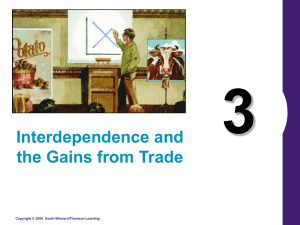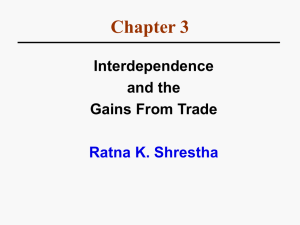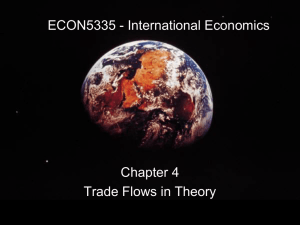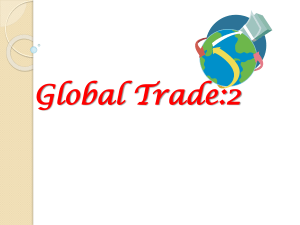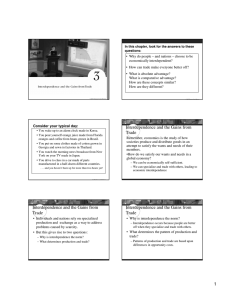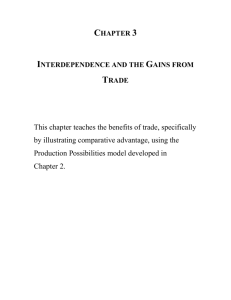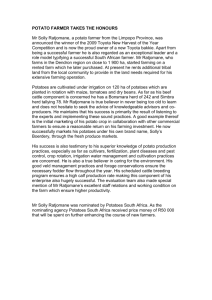Comparative Advantage/Trade interdependence
advertisement
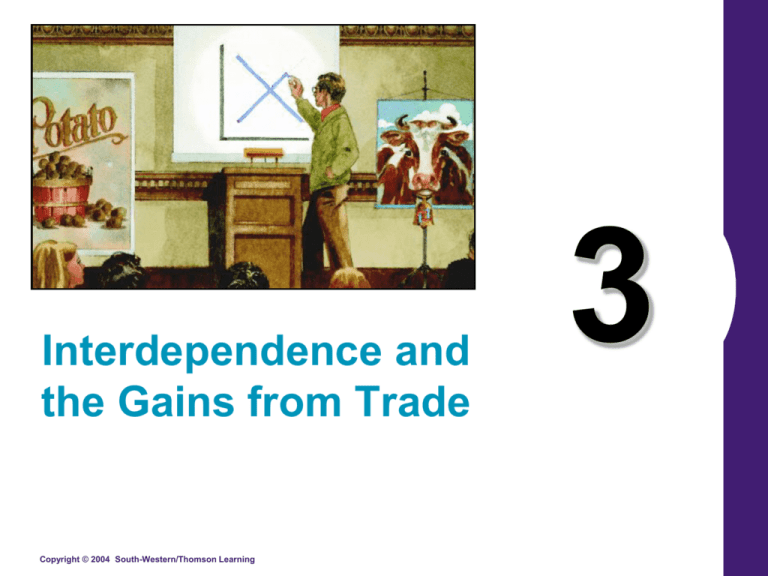
Interdependence and the Gains from Trade Copyright © 2004 South-Western/Thomson Learning 3 Absolute Advantage • absolute advantage is when … • a producer can make more of a good/service within a given amount of time and resources. Copyright © 2004 South-Western Comparative Advantage • comparative advantage is when … A producer has the smaller opportunity cost of producing the good or service than other people. Copyright © 2004 South-Western A PARABLE FOR THE MODERN ECONOMY • Imagine . . . • only two goods: potatoes and meat • only two people: a potato farmer and a cattle rancher • What should each produce? • Why should they trade? Copyright © 2004 South-Western The Production Opportunities of the Farmer and Rancher Copyright © 2004 South-Western Production Possibilities • Self-Sufficiency • By ignoring each other: • Each consumes what they produce. • The production possibilities frontier is also the consumption possibilities frontier. • Economic gains are diminished. Copyright © 2004 South-Western The Production Possibilities Curve (a) The Farmer ’s Production Possibilities Frontier Meat (ounces) If there is no trade, the farmer chooses this production and consumption. 8 4 0 A 16 32 Potatoes (ounces) Copyright©2003 Southwestern/Thomson Learning The Production Possibilities Curve (b) The Rancher ’s Production Possibilities Frontier Meat (ounces) 24 If there is no trade, the rancher chooses this production and consumption. 12 0 B 24 48 Potatoes (ounces) Copyright©2003 Southwestern/Thomson Learning Specialization and Trade • The Farmer and the Rancher Specialize and Trade • Each would be better off if they specialized in producing the product they are more suited to produce, and then trade with each other. The farmer should produce potatoes. The rancher should produce meat. Copyright © 2004 South-Western How Trade Expands the Set of Consumption Opportunities (a) The Farmer’s Production and Consumption Meat (ounces) 8 Farmer's consumption with trade A* 5 4 Farmer's production and consumption without trade A Farmer's production with trade 0 32 16 Potatoes (ounces) 17 Copyright©2003 Southwestern/Thomson Learning How Trade Expands the Set of Consumption Opportunities (b) The Rancher’s Production and Consumption Meat (ounces) Rancher's production with trade 24 Rancher's consumption with trade 18 13 B* B 12 0 12 24 27 Rancher's production and consumption without trade 48 Potatoes (ounces) Copyright © 2004 South-Western The Gains from Trade: A Summary Copyright © 2004 South-Western Comparative Advantage and Gains From Trade State Oregon Apples Timber Opp. Cost of 1 Timber = Opp. Cost of 1 Apple = 10 40 .25 apple 4 timber Washington 40 10 4 apple .25 timber Copyright © 2004 South-Western THE PRINCIPLE OF COMPARATIVE ADVANTAGE • Differences in the costs of production determine the following: • Who should produce what? • How much should be traded for each product? Who can produce potatoes at a lower cost--the farmer or the rancher? Copyright © 2004 South-Western THE PRINCIPLE OF COMPARATIVE ADVANTAGE • Differences in Costs of Production • Two ways to measure differences in costs of production: • The number of hours required to produce a unit of output (for example, one pound of potatoes). • The opportunity cost of sacrificing one good for another. Copyright © 2004 South-Western Absolute Advantage • The Rancher needs only 10 minutes to produce an ounce of potatoes, whereas the Farmer needs 15 minutes. • The Rancher needs only 20 minutes to produce an ounce of meat, whereas the Farmer needs 60 minutes. The Rancher has an absolute advantage in the production of both meat and potatoes. Copyright © 2004 South-Western Comparative Advantage and Trade • Who has the absolute advantage? • The farmer or the rancher? • Who has the comparative advantage? • The farmer or the rancher? Copyright © 2004 South-Western Table 3 The Opportunity Cost of Meat and Potatoes Opportunity Cost of: 1 oz of Meat 1 oz of Potatoes Farmer 4 oz potatoes 1/4 oz meat Rancher 2 oz potatoes 1/2 oz meat Copyright © 2004 South-Western Comparative Advantage and Trade • The Rancher’s opportunity cost of an ounce of potatoes is ¼ an ounce of meat, whereas the Farmer’s opportunity cost of an ounce of potatoes is ½ an ounce of meat. • The Rancher’s opportunity cost of a pound of meat is only 4 ounces of potatoes, while the Farmer’s opportunity cost of an ounce of meat is only 2 ounces of potatoes... Copyright © 2004 South-Western Comparative Advantage and Trade …so, the Rancher has a comparative advantage in the production of meat but the Farmer has a comparative advantage in the production of potatoes. Copyright © 2004 South-Western Comparative Advantage and Trade • Comparative advantage and differences in opportunity costs are the basis for specialized production and trade. • Whenever potential trading parties have differences in opportunity costs, they can each benefit from trade. Copyright © 2004 South-Western Comparative Advantage and Trade • Benefits of Trade • Trade can benefit everyone in a society because it allows people to specialize in activities in which they have a comparative advantage. Copyright © 2004 South-Western FYI—The Legacy of Adam Smith and David Ricardo • Adam Smith • In his 1776 book An Inquiry into the Nature and Causes of the Wealth of Nations, Adam Smith performed a detailed analysis of trade and economic interdependence, which economists still adhere to today. • David Ricardo • In his 1816 book Principles of Political Economy and Taxation, David Ricardo developed the principle of comparative advantage as we know it today. Copyright © 2004 South-Western APPLICATIONS OF COMPARATIVE ADVANTAGE • Should Tiger Woods Mow His Own Lawn? ? ? ? Copyright © 2004 South-Western APPLICATIONS OF COMPARATIVE ADVANTAGE • Should the United States Trade with Other Countries? • Each country has many citizens with different interests. International trade can make some individuals worse off, even as it makes the country as a whole better off. • Imports—goods produced abroad and sold domestically • Exports—goods produced domestically and sold abroad Copyright © 2004 South-Western • Consider your typical day: • You wake up to an alarm clock made in Korea. • You pour yourself orange juice made from Florida oranges and coffee from beans grown in Brazil. • You put on some clothes made of cotton grown in Georgia and sewn in factories in Thailand. • You watch the morning news broadcast from New York on your TV made in Japan. • You drive to class in a car made of parts manufactured in a half-dozen different countries. Copyright © 2004 South-Western • . . . and you haven’t been up for more than two hours yet! Copyright © 2004 South-Western Interdependence and the Gains from Trade • Remember, economics is the study of how societies produce and distribute goods in an attempt to satisfy the wants and needs of its members. Copyright © 2004 South-Western Interdependence and the Gains from Trade • How do we satisfy our wants and needs in a global economy? • We can be economically self-sufficient. • We can specialize and trade with others, leading to economic interdependence. Copyright © 2004 South-Western Interdependence and the Gains from Trade • Individuals and nations rely on specialized production and exchange as a way to address problems caused by scarcity. • But this gives rise to two questions: • Why is interdependence the norm? • What determines production and trade? Copyright © 2004 South-Western Interdependence and the Gains from Trade • Why is interdependence the norm? • Interdependence occurs because people are better off when they specialize and trade with others. • What determines the pattern of production and trade? • Patterns of production and trade are based upon differences in opportunity costs. Copyright © 2004 South-Western
